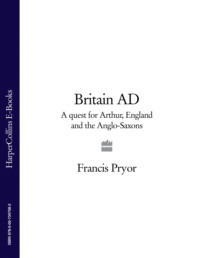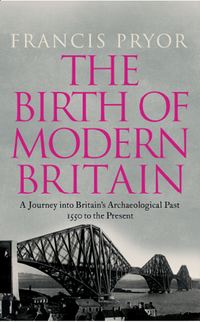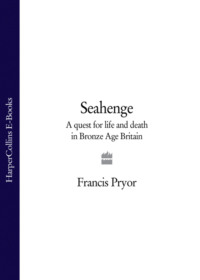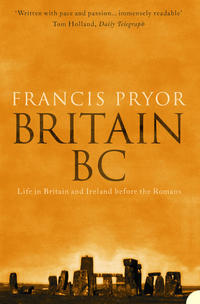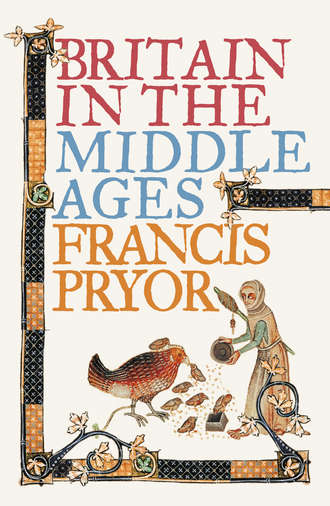
Полная версия
Britain in the Middle Ages: An Archaeological History


BRITAIN IN THE MIDDLE AGES
An Archaeological History
FRANCIS PRYOR

DEDICATION
This book is dedicated to the memory of
DR CHRIS SALISBURY
friend, doctor and archaeologist
CONTENTS
Cover
Title Page
Dedication
Table: Dates and Periods
Introduction: Archaeology and the Medieval Period
PART I: On Britons, Saxons and Vikings (650–1066)
1 The North/South Divide of the Middle Saxon Period
2 Enter the Vikings
3 Rural Life in Late Saxon Times
4 Urban Life in Late Saxon Times
PART II: The Middle Ages (1066–1550)
5 Urban Life in the Middle Ages
6 Rural Life in the Middle Ages
7 Trade, Industry and Security
8 The End of the Middle Ages?
Acknowledgements
P.S. Ideas, Interviews & Features …
About the Author
Excavating the Past: Francis Pryor talks to Louise Tucker
Life at a Glance
Top Ten History/Archaeology Books
A Writer’s Life
About the Book
Archaeology and History in Times of Change
Read on
Have You Read?
Find Out More
Index
About the Author
Notes
Praise
Also by the Author
Copyright
About the Publisher
DATES AND PERIODS
Archaeological Period* Dates (AD) Defining or transitional events Notes Roman 43–410 Withdrawal of last Roman troops from Britain c.409 ‘Sub-Roman’ or Post-Roman 410–50 This is sometimes Post-Roman included in the Early Saxon period ‘Early Medieval’ c. 410–1066 A term generally used to describe pre-Norman times Early Saxon 450–650 Previously known as Pagan Saxon Middle Saxon 650–850 Late Saxon 850–1066 Norman Conquest (Battle of Hastings 1066) ‘Saxo-Norman’ 850–1150 A general descriptive term Middle Ages (or ‘Later Medieval’) 1066–1550 These may be subdivided thus: Early Middle Ages 1066–1350 1348–49 first wave of Black Death Later Middle Ages 1350–1550 Dissolution of the monasteries 1536–40. The Reformation (Church of England legally established 1559) Sometimes referred to as the ‘Transitional Period’ Post-Medieval 1550–present* Terms placed in quotes are used in a general sense. They are not archaeological periods sensu stricto.
INTRODUCTION
Archaeology and the Medieval Period
I found the archaeological exploration involved in the writing of my previous book, Britain AD, so fascinating that I decided I had to carry the story forward in time. By comparison with Britain AD, I have fewer axes to grind in this book. This is probably because hypothetical mass-migration and invasion are not contentious issues after the three centuries that followed the Roman withdrawal of AD 410.
In this book I want to take an archaeological look at medieval Britain. The word ‘medieval’ can be taken to mean many things. Here I will use it as a chronological label, which for present purposes begins around AD 650, the end of the period known to archaeologists as the Early Saxon. The finish date is harder to pin down, and later we will see that there are good reasons for this, but here I will follow most archaeological opinion by selecting the mid-sixteenth century, say 1550, and the death of Henry VIII (1547).
This is not a textbook, nor is it a book of social or political history.1 If you are looking for an authoritative account of the Tudors, the Plantagenets or the Peasants’ Revolt, then this is not it. This will be what used to be called a ‘narrative history’ – except that there is more here about archaeology than about history. I have made greater efforts to explain fields and hedges, waterfronts and trade than the achievements of individual rulers. Another way of describing a narrative account is to see it as a diary or journal of the author’s own exploration of a particular subject. That, I think, is closer to what I have attempted to do.
Being a prehistorian of the Neolithic, Bronze and Iron Ages, I am most familiar with the sites and objects of the last four millennia BC, as revealed by excavation. This experience gives me an unusual perspective on medieval times. As we will see shortly, I tend to view the past in the long term. I am more concerned with the processes of social and political change than with a detailed chronicle of the events that marked the progress of those changes. To use a phrase that is currently popular, this book is an attempt to write a sort of ‘joined up’ archaeology, where the changes seen in the ground can be related to their causes in the ancient world. This approach is perhaps easier for historians, who are good at identifying key events, their causes and consequences. Archaeologists, on the other hand, have found that the techniques available to them make the identification of historical events a problem.
One example will suffice. We know for a fact that Boudica, the rebellious Queen of the Iceni, nearly threw the occupying Roman troops out of Britain during her uprising in AD 60 and 61. In the course of that revolt her forces set fire to parts of towns in eastern England. Accordingly, when archaeologists working in that region find evidence for burning around the middle of the first century AD, they often attribute it to the Boudican revolt. In that way the ‘evidence’ for large-scale destruction is increasing every year. But in antiquity, just as today, fires are not always started deliberately. Very often they happen by accident, and the archaeologist is presented with the near-impossible task of differentiating between Boudica and, say, the results of a bakery fire. To make matters worse, nowadays the press are always on the prowl for news stories, and fresh evidence for the heroic warrior queen’s prowess always makes excellent copy.
This inability to tie down specific historical events has led archaeologists to turn their attention to the longer-term processes that lay behind the development of society in various parts of the world. Today the profession is branching out. There is a proliferation of fresh approaches to the past. Some, the so-called culture-historicists, stay with historical reconstruction. Others (processualists) prefer to work with problems to do with social process; their way of working is heavily influenced by anthropology. But there are many other ways of ‘doing’ archaeology today, ranging from Marxist to cognitive to neo-structuralists and various strands of post-processualists, who take their ultimate inspiration from post-modern philosophers such as Derrida.2 Some of their ideas, deconstruction for example, have proved very useful. I believe this diversity of approach gives our discipline strength and resilience. My own approach is a hybrid of at least three of these methods – I think.
The colourfully misnamed Dark Ages mark a return of sorts to prehistory, so far as the archaeologist is concerned. During the half century or so of post-Roman times and the subsequent Early Saxon Period (AD 450–650), reliable written documents are rare, and provide us with far less information than the abundance of new archaeological discoveries, whose sheer quantity today is almost overwhelming. Whether or not you accept the argument of Britain AD, that the indigenous population of Britain did not fall victim to Anglo-Saxon ‘ethnic cleansing’, as the distinguished historian David Starkey suggested in the first episode of his television series Monarchy (2004), it is hard to deny that archaeology is revealing a huge amount about Dark Age Britain. But what about the subsequent periods: does archaeology have a role to play in times when documentary evidence becomes more abundant?
There was a rapid increase, indeed ‘explosion’ would scarcely be an exaggeration, of written documentary sources in the mid-thirteenth century. These documents are mainly about day-to-day transactions, to do with trade, dwellings and land tenure. They are of enormous importance to the study of the way people lived their lives, in both town and country. But do they allow us to paint a full picture of life in the Middle Ages? The archaeologist Paul Stamper thinks not: ‘traditionally, few historians exhibited any interest whatsoever in material culture, whether it be the layout of a village’s fields, the design of its houses, or the range of their contents. That was especially so with regard to peasant society, which was assumed to be (in every sense) rude, crude and unworthy of scholarly investigation.’ He then explains that most historical records are ‘terse, factual memoranda’. They throw little light on how or why certain things took place. ‘Archaeology’s ultimate access to a much larger dataset, and to one with a degree of detail denied to the historian, makes the investigation of explanation far more feasible.’3
It is generally believed that day-to-day documents, such as deeds or records arising from other transactions, are by their very nature reliable; but as a farmer who has to deal with the welter of impossibly long forms and other bureaucratic nonsense that has recently sprung up, I have my doubts: this modern documentation can tell a cautionary tale that is relevant to history. Recently the government told farmers that it was illegal to bury dead animals. In future, they announced, all fallen stock was to be disposed of by licensed operators, who would burn the carcasses. This procedure would be accompanied by appropriate and abundant paperwork. But typically of what so often happens today, no practical provision was made for the collection of carcasses. Licensed operators were hard to find, or were miles away. Like other farmers, I tried to follow the new law, but became disgusted by the stench of rotting flesh as a dead animal decomposed for a week in the June heat while it waited for collection. So I buried it. And I may even have buried a few more. The point is that for several months most farmers did what I did – since there was no other option. But my farm paperwork gives no hint that this was happening, because I have no wish to incriminate myself. However, in a hundred years’ time an archaeologist digging in my wood could tell from the ear tags on the dead animals that I was breaking the letter of the law. So the documents would say one thing and the archaeology another. And I know which one I would trust.
I do not want to become embroiled in an unconstructive argument between archaeologists and historians, because I believe their two subjects are slowly becoming closer. But wherever possible I will try to make use of those comparatively rare individuals, such as Colin Platt, Tom Williamson, Paul Stamper and Chris Dyer, who seem equally at home in both worlds. I also like the work of historians with a breadth of vision, able to deal effortlessly with great expanses of time and space. For me Jacques Le Goff is just such a historian, and his recent book The Birth of Europe has helped me see the wood through the medieval trees.4 It is also perhaps worth noting that certain historians still seem to be oblivious – sometimes even comfortably oblivious – to the existence of archaeology. I console myself with the thought that as time passes they will have to change.
I have spent over thirty years excavating sites of the last five millennia BC and the first millennium AD, mostly in eastern England. In the course of this work I have taken a long view of the past. This extended perspective partly reflects the imprecision of current dating methods – for example, radiocarbon dates are often accurate only to two or three centuries – but it also results from theoretical approaches that have been adopted by prehistorians since the 1960s. In the last four decades of the twentieth century prehistorians became less interested in one-off events and turned their attention to the gradually evolving processes of social change.
There was also a move away from a straightforward, or functionalist, view of the past. This new approach laid greater emphasis on the roles of symbolism, ritual and structure within the processes of change. Other post-modern approaches have been highly influential. Archaeological evidence, for example, lends itself readily to deconstruction. The result has been a long-term or strategic overview of the past which non-specialists find appealing, because it is often relevant to current issues, such as the development of political authority or the role of religion within society. I think these are positive trends, because archaeology must be relevant to modern life, or it will not survive for long.
It would perhaps be useful if at this stage I gave an indication of my long-term view of the human past. I will take an essentially British perspective. The story begins with Prehistory, which can be subdivided into three: Early Prehistory, being everything from the arrival of the first humans about half a million years ago until the appearance of Homo sapiens, around 40,000 years ago; Middle Prehistory ends with the introduction of farming about 5000 BC, or slightly earlier; Late Prehistory extends through the Neolithic and most of the Bronze Age, until the early first millennium BC, after which we are in the Iron Age and the next of my three main periods, Antiquity.
In Britain and France, Early Antiquity ends with the arrival of the Roman Empire, but in north-western Europe outside the Roman Empire there is a seamless transition into Middle Antiquity in the early centuries AD. Late Antiquity starts in the latter part of the Roman period and ends sometime around 600–650, when major social, economic and political changes begin to happen.
The last of my three eras is the Modern Period. Its Early phase starts in Britain around AD 650 with the start of the Middle Saxon period. This was a time of rapidly growing trade networks and the emergence of the first early medieval European states. Soon we have the establishment of the first true post-Roman towns. It ends around 1350 with the Black Death (1348). The Middle Modern or ‘Transitional’ Period ends around 1550, the date that most archaeologists regard as the close of the Middle Ages; this book will be about the Early and Middle Modern periods, as defined here. The Late Modern Period starts around 1550 and extends until the present. I should also add here that I regard currently fashionable attempts to define a new ‘post-industrial’ era as being premature. We are far too close in time to view our culture with any clarity at all. Maybe historians in a hundred years’ time will have acquired suitable perspective. Maybe.
Period Start Date Events Early Prehistory 500,000 years ago Humans in north-western Europe Middle Prehistory 40,000 years ago First Homo sapiens Late Prehistory 5000 BC Farming introduced Early Antiquity 750 BC Iron and the Iron Age Middle Antiquity 100 BC The Roman Empire Late Antiquity AD 300 Post-Roman times Early Modern AD 600–50 Carolingian Empire Arab Empire. Early Middle Ages Middle Modern (or ‘Transitional Period’) AD 1350 Black Death, Later Middle Ages, Reformation Late Modern AD 1550–present Industrial/agricultural ‘revolutions’ etc.I described how I would divide up my ‘long view’ of the human past because it provides at least partial justification for why I do not regard the Middle Ages as being ‘Middle’ at all. The term was first used in the Renaissance to describe the period between the Classical world and that of the Renaissance. This was a perspective which viewed that Classical world through modern eyes. That way of looking at the past has little or nothing to do with hard historical or archaeological reality. It has more to do with value judgements about art, literature and knowledge than the development of human culture or society.
Historians generally end the Middle Ages with the Battle of Bosworth (1485), whereas archaeologists, who, Paul Stamper believes, are more attuned to the material world, tend to continue it for another half-century, into the 1540s and the Dissolution of the Monasteries by Henry VIII. Again, some historians and many lay people see the Middle Ages as starting with the Norman Conquest, but I want to extend them back in time to include the earliest kingdoms of Saxon England and the Scandinavian (Viking) presence. I also want to bridge the gap between the world of written history and that historical (but not archaeological) twilight zone the Dark Ages, which had certainly come to an end by AD 650. The Synod of Whitby, which sorted out the direction the Church in Britain would take for the next millennium, took place in 664. It also makes little sense to ignore the early-tenth-century survey and reapportionment of the countryside – one of medieval archaeology’s most important contributions to the study of the period. This great survey, which happened in the decades after 900, provided the essential framework for subsequent developments.
The term ‘Middle Ages’ suggests a time between two other ages which were marked by major social and cultural advances. Being betwixt and between, the Middle Ages are often portrayed as a period when nothing much happened. As I researched this book I realised that this is very far from the truth. I am in no doubt that the centuries of the Middle Ages were the time when the modern world was actually conceived and started the process of development, at first slowly, but latterly with gathering pace. This was when Britain moved from the realms of Late Antiquity into a more familiar world: roads and parishes became fixed; institutions such as the Church and local government came into being and industry became truly industrial, with manufacturing starting to be organised on a national basis. Midway through the period international trade had become routine.
For too long the Middle Ages have been portrayed as a period of slow progress, characterised by feudalism and superstition. Certainly that was the impression I gained at school. Industry was seen as small in scale, farming was held back by the manorial system, and life in town was hidebound by guilds and, of course, the repressive power of the Church. More recently, archaeology has shown that the Middle Ages were far from static. The Church did not exert a dead hand. There was real progress, which happened remarkably swiftly. The latest archaeological evidence shows beyond any doubt that Britain was an integrated part of Europe in the four centuries before the Norman Conquest. This has been a major revelation that I will discuss at some length in the first three chapters of this book. It seems now that the Reformation and the Renaissance were natural processes that had to happen if the progress made in the medieval period was to continue.
I am not alone in bemoaning some current perspectives on the Middle Ages which see the period as somehow irrelevant to the modern world because (it is said) very little actually changed. This view has it that the developments that were to lead to the modern world took place during and after the Renaissance. As I hope this book will show, nothing could be further from the truth. However, despite those reasons to the contrary, I shall continue to use the term ‘Middle Ages’, because it’s a label that has stuck, and besides, my term ‘Middle Modern’ has too many ‘M’s and is confusingly similar to the one it tries to replace.
I have mentioned some of the theoretical differences between archaeology and history, but now I want to address a practical issue arising from these contrasts. It concerns the organisation and layout of this book. While our knowledge of the documentary sources relating to Britain before the Norman Conquest remains essentially static, new archaeological discoveries are having a very profound effect on our understanding of the Middle and Late Saxon periods.
The four centuries prior to 1050 are known as the Middle (650–850) and Late (850–1066) Saxon periods, which I will sometimes lump together in the deliberately vague ‘Later Saxon’. The term ‘Saxo-Norman’ is also sometimes used to describe the overlap between Late Saxon and early Norman in the mid-to-late eleventh century. As I have already suggested, it is now appreciated that the first four hundred years of the medieval period were fundamental to the development of British society in the Middle Ages. It was the time when Britain acquired its county system and its basic administrative geography. It was the time, too, when English became the accepted language in the most populated areas. It was, of course, also the period of the Vikings, who we must now see as far more than the rapists and pillagers in horned helmets beloved of movie-makers. For me the story of Later Saxon and Saxo-Norman Britain is as exciting as archaeology gets, because it is currently going through a period of major reappraisal. Turmoil might be a better term. Nothing seems beyond dispute, whether it be the role of the Vikings or Britain’s place within Charlemagne’s Europe. The more we understand about Viking Britain and the earliest England, the more we realise that their inhabitants did not dwell in Little Britain. They were part of a far larger world.


